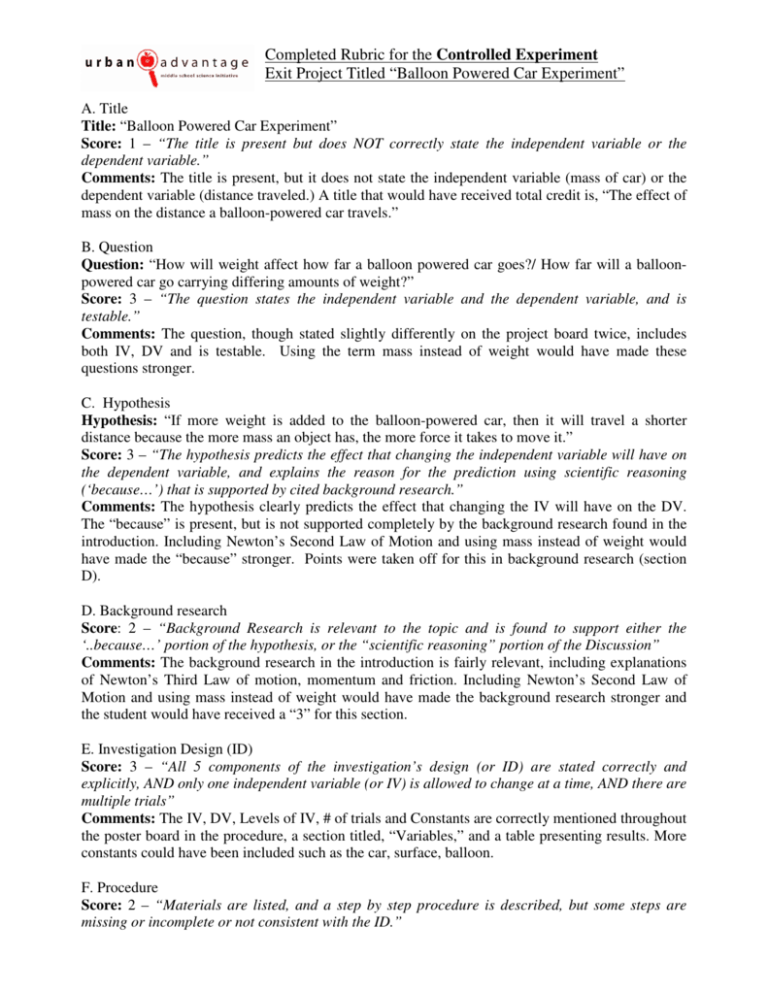Balloon Car Experiment Rubric: Science Project Assessment
advertisement

Completed Rubric for the Controlled Experiment Exit Project Titled “Balloon Powered Car Experiment” A. Title Title: “Balloon Powered Car Experiment” Score: 1 – “The title is present but does NOT correctly state the independent variable or the dependent variable.” Comments: The title is present, but it does not state the independent variable (mass of car) or the dependent variable (distance traveled.) A title that would have received total credit is, “The effect of mass on the distance a balloon-powered car travels.” B. Question Question: “How will weight affect how far a balloon powered car goes?/ How far will a balloonpowered car go carrying differing amounts of weight?” Score: 3 – “The question states the independent variable and the dependent variable, and is testable.” Comments: The question, though stated slightly differently on the project board twice, includes both IV, DV and is testable. Using the term mass instead of weight would have made these questions stronger. C. Hypothesis Hypothesis: “If more weight is added to the balloon-powered car, then it will travel a shorter distance because the more mass an object has, the more force it takes to move it.” Score: 3 – “The hypothesis predicts the effect that changing the independent variable will have on the dependent variable, and explains the reason for the prediction using scientific reasoning (‘because…’) that is supported by cited background research.” Comments: The hypothesis clearly predicts the effect that changing the IV will have on the DV. The “because” is present, but is not supported completely by the background research found in the introduction. Including Newton’s Second Law of Motion and using mass instead of weight would have made the “because” stronger. Points were taken off for this in background research (section D). D. Background research Score: 2 – “Background Research is relevant to the topic and is found to support either the ‘..because…’ portion of the hypothesis, or the “scientific reasoning” portion of the Discussion” Comments: The background research in the introduction is fairly relevant, including explanations of Newton’s Third Law of motion, momentum and friction. Including Newton’s Second Law of Motion and using mass instead of weight would have made the background research stronger and the student would have received a “3” for this section. E. Investigation Design (ID) Score: 3 – “All 5 components of the investigation’s design (or ID) are stated correctly and explicitly, AND only one independent variable (or IV) is allowed to change at a time, AND there are multiple trials” Comments: The IV, DV, Levels of IV, # of trials and Constants are correctly mentioned throughout the poster board in the procedure, a section titled, “Variables,” and a table presenting results. More constants could have been included such as the car, surface, balloon. F. Procedure Score: 2 – “Materials are listed, and a step by step procedure is described, but some steps are missing or incomplete or not consistent with the ID.” Comments: A step-by-step procedure, including materials is present along with a diagram and photograph of the balloon powered car. There was a small inconstancy in materials used to add mass to the car. In the discussion, it is stated that at one point, 25 grams of clay was added to the car, not a 25-gram mass as noted in the materials list. If more detail for the construction of the balloon-powered car were included as well as a little more detail in the procedure the student would have received a “3” for this section. G. Data/Results Score: 3 – “Data table(s) and graph(s) are accurate, include labels (titles, correct units of measure), and are relevant to the original question. Trends or patterns in the data are identified and summarized. Data address the hypothesis and the correct tables and/or graphs have been chosen to clearly answer the original question.” Comments: The data table and bar graph are accurate, include correct labels and are relevant to the original question. The averages are missing on the data table, but it is included in the graph. Trends and patterns are identified and summarized in the observation section. A line graph or scatter-plot with a trend line with appropriate spacing along the X-axis might have resulted in more accurate representations of the data H. Discussion/Conclusion Score: 3 – “Discussion/Conclusion makes a claim (i.e., the hypothesis is or is not supported…), supports the claim with evidence, and uses reasoning--in the form of connections to scientific concepts--to relate claim and evidence. It is important that the Discussion/Conclusion refer to relevant scientific concepts (content knowledge) to explain why the claim and evidence are related. Scientific sources supporting results should be referred to and cited in the discussion. Reflections and ‘Next Steps’ are included in the Discussion/Conclusion.” Comments: Claim based on the hypothesis is supported with evidence from this investigation and scientific reasoning present in the introduction. Reference to Newton’s Second Law is still missing, but the term “weight” is replaced with the more accurate term “mass”. Includes reflections, next steps and sources of possible experimental error. I. Literature Cited Score: 0 – “Not attempted.” Comments: No sources were cited even though there is background research present in the introduction. Final Score- 42/51 or 82% Project Section A. Title B. Question C. Hypothesis D. Background Research E. Investigation Design (ID) F. Procedure G. Data/Results H. Discussion/Conclusion I. Literature Cited Score (0-3) Weight x1 x1 x2 x2 x2 x2 x3 x3 x1 Total weighted score Final Score (%) = Total weighted score/51 x 100 1 3 3 2 3 2 3 3 0 Weighted Score = 1 = 3 = 6 = 4 = 6 = 4 = 9 = 9 = 0 = 42 (51 max) = 82%









